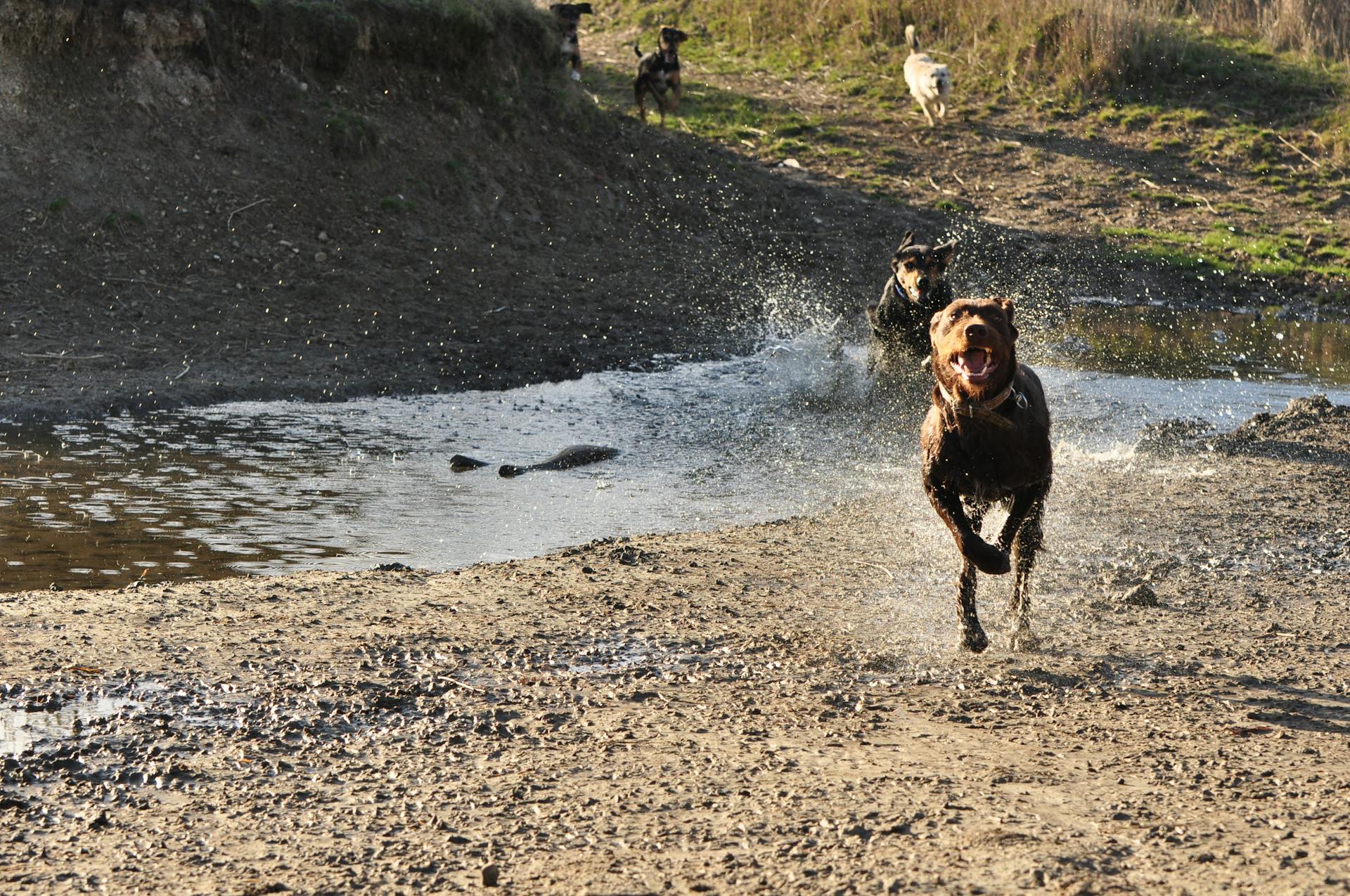
Dogs stealing food can be a frustrating problem, but with consistent training and some simple safety precautions, you can minimize the risk of your furry friend getting into trouble.
One of the main reasons dogs steal food is because they're opportunistic scavengers, always on the lookout for an easy meal.
To prevent this, make sure to keep all food out of reach of your dog, including counters, tables, and trash cans.
Dogs can sniff out food from far away, so it's essential to be proactive in securing your kitchen.
Understanding Dog Behavior
Dogs steal food because they're naturally curious and love to explore with their mouths. It's a common behavior in puppies and dogs alike.
Puppies and dogs will pick up or chew most things they come across, including items they're not supposed to. This is because they're learning and figuring out what's acceptable and what's not.
Some dogs learn to steal food by playing a game with their owners, who chase them and try to get the item back. This can be misinterpreted as a fun game by the dog, leading them to repeat the behavior.
Dogs may also learn to steal food by being rewarded with attention or affection when they pick up an item. This can create a positive association in the dog's mind, making them more likely to repeat the behavior.
Teaching your dog an alternative behavior, such as going to their place or engaging in a different activity, can help redirect their attention away from food on the counter. This can be done by providing a food-stuffed toy or a dog-safe chew in another area of the home.
A successful drop command can help prevent damage and possessive aggression, but it won't stop the stealing behavior entirely. If your dog has stolen something that can't be ignored, it's best to use a leash and head halter to safely remove the object while restraining the mouth.
To teach your dog to go to their place, start by rewarding them for interacting with the bed or crate. Gradually increase the duration, distance, and distractions while they're in their place, and remember to toss treats on the bed while you cook to thank them for their good behavior.
Training and Prevention
To stop counter-surfing, be proactive about how you prep and store food in your kitchen by storing it in airtight containers in cabinets or refrigerators.
Consistency is key in changing this habit, so make sure the entire household is on board with management and prevention.
Any mistakes or forgotten food will set you back in your training program, so it's essential to be vigilant, especially with puppies and adolescent dogs who might discover a "self-rewarding" act and continue to do it.
Worth a look: Why Are Dogs so Food Motivated
Training 'Leave It'
Training 'Leave It' is a crucial skill for any dog to learn. This command helps prevent unwanted behaviors such as stealing food or picking up trash.
To start, you'll need a treat that your dog loves. Choose a quiet area with minimal distractions.
Begin by holding a treat in front of your dog's nose and saying "leave it." As soon as they look away from the treat, praise them and give them a different treat as a reward.
This process should be repeated several times until your dog starts to understand the command.
Check this out: Should You Leave Food Out for Dogs
Be Consistent

Consistency is key when it comes to changing your dog's counter-surfing habit. Any mistakes or forgotten food will set you back in your training program.
To stop this habit, you need to be consistent in your approach. Make sure the entire household is on board with management and prevention.
Removing all temptation and never allowing your dog to eat off the counter will make it far easier to teach them new behavior patterns. This will eventually eliminate counter-surfing altogether.
Managing Stealing Behavior
Preventing access to problem areas is key to stopping your dog from stealing in your absence. This can be achieved by using "booby traps" such as Snappy Trainers or motion detector alarms.
Booby traps can be an effective way to keep your pet away from an area or object, and with time, your dog may learn to avoid the area or the sight of the deterrent device.
Teaching your dog an alternative behavior can also help counter-surfing. Give your dog a food-stuffed toy or a dog-safe chew in another area of your home to distract them from the counter.
Teaching your dog to swap things can also be helpful. Offer your dog a better item before trying to take what they have away, and return their item to them shortly after swapping it.
Ignoring your dog when they steal is crucial, as it prevents them from gaining your attention. Wait until they lose interest and drop the item, then encourage them to do something else instead.
Providing a "place" for your dog to go to while you have food out on the counter can also be effective. Teach your dog to go to their place without any distractions present, and reward them with treats for doing so.
Using a slow-release toy filled with kibble can also keep your dog busy in another room, distracting them from the kitchen and any goodies.
Dogs will repeat anything that works out well for them, so it's essential to make sure the stealing behavior is not rewarded. Avoid picking up the item straight away, and instead, encourage your dog to do something else instead.
Prevent Counter-Surfing
Preventing counter-surfing is the best way to stop it from happening in the first place. If your dog never finds food on the counter, they won't think of it as a source of food and won't bother looking there.
Small amounts of forgotten food can cause your dog to develop a bad habit, especially with puppies and adolescent dogs. They'll continue to do it if they discover a "self-rewarding" act, which means they'll reward themselves with what they find, in this case, food.
Keep food in airtight containers in cabinets or refrigerators to avoid tempting your dog. If you're cooking, try to avoid putting food near the edge of the counter.
Consistently keeping food off the counter will make it harder for your dog to find something to eat even if they do pop up to look.
Dealing with Stealing Dogs
Dogs steal because they've learned to take items they're not supposed to, often due to their owners unintentionally encouraging this behavior.
They learn to take items by picking them up, having their owners chase them, and then pulling the item out of their mouth, which feels like a game to the dog.
Teaching your dog a "leave it" command can help prevent damage and possessive aggression, but it won't stop stealing behavior entirely.
If your dog has stolen something valuable or that could harm them, try making a distraction that doesn't involve talking, touching, or looking at them.
You can walk out of the room to see if they follow you or make a noise by opening a door.
A distraction like opening the fridge often works to get a dog's attention.
Once your dog has dropped the item and moved away from it, get them involved in something else, like scattering treats for them to sniff out in a different room.
Preventing access to problem areas or using "booby traps" can be an effective way to keep your dog away from an area or object.
Examples of booby traps include Snappy Trainers, bitter or hot tasting sprays, motion detector alarms, and electronic avoidance devices.
To prevent food stealing, consider using two trash containers in your kitchen: a small one for food items that's out of reach, and a large one for non-edible trash that can be left out in the room.
Supervising your dog at all times and ensuring they have a sufficiently enriched and predictable daily routine can help prevent unwanted behaviors.
If your dog steals in your presence, use a long leash attached to a head halter and give a "leave it" command when they approach objects they might chew or areas you consider off-limits.
Some dogs may learn to steal because they're unsupervised and don't have an acceptable activity to engage in.
To prevent this, crate or confinement training may be necessary, or you can arrange the environment so that your dog can't get to items or areas you don't want them to access.
Here are some options for preventing access to restricted areas:
- Crate or confinement training
- Barrier gates
- Child proofing devices
- Motion sensor devices
- Booby traps with taste aversives or motion detector alarms
Sources
- https://vcahospitals.com/know-your-pet/dog-behavior-problems-stealing-and-stay-away
- https://www.akc.org/expert-advice/training/how-to-prevent-your-dog-from-stealing-food/
- https://www.dogstrust.org.uk/dog-advice/training/unwanted-behaviours/stop-your-dog-stealing
- https://anticruelty.org/pet-library/stealing-counter-surfing-and-garbage-raiding
- https://www.whole-dog-journal.com/training/counter-productive-how-to-keep-your-dog-from-stealing-unattended-food-and-other-edible-items/
Featured Images: pexels.com


